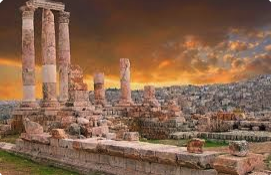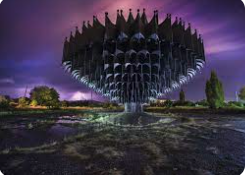Description
Umm Qais Ruins
This archaeological site, also known as Gadara, is often referred to as the “Pompeii of the Middle East” due to its remarkable state of preservation.
The most prominent attractions at Umm Qais Ruins include the stunning Greco-Roman theater, which offers panoramic views of the surrounding countryside. This well-preserved theater was once a hub for cultural events and performances. Visitors can also explore the remains of the city’s streets, temples, and residential buildings, gaining a glimpse into Roman and Byzantine civilizations.The site’s standout feature is the Decapolis, a collection of ten Roman cities that formed an alliance for economic and cultural prosperity. Gadara was one of these ten cities, and its ruins are a fascinating testament to its once-thriving status.
Umm Qais’ strategic location atop a hill provides visitors with breathtaking views that span across the Jordan Valley, the Sea of Galilee (Lake Tiberias), and the Golan Heights. This makes it an ideal spot for photography enthusiasts, nature lovers, and anyone seeking a serene and awe-inspiring experience.
Gadara Theater
This ancient Roman amphitheater, dating back to the 2nd century AD, offers visitors a fascinating glimpse into the region’s rich history.
One of the main highlights of Gadara Theater is its impressive architecture. The theater is well-preserved, with its seating capacity of up to 3,000 spectators. The design of the theater allows for excellent acoustics, making it a venue that was once used for performances and gatherings. The theater also offers breathtaking panoramic views of the surrounding landscapes, including the Sea of Galilee, Golan Heights, and the Jordan Valley. Visitors can enjoy stunning photo opportunities and take in the beauty of the region while exploring this historical site.
Ma’in Hot Springs
Situated in the breathtaking Amman Governorate, this natural spa is known for its healing properties and stunning surroundings.
The hot springs are located around 30 kilometers southeast of Amman, making them easily accessible for both local and international visitors. The hot mineral-rich water reaches temperatures of up to 63 degrees Celsius and is believed to have therapeutic.
Besides the healing properties, Ma’in Hot Springs offers a picturesque setting with majestic waterfalls cascading down cliffs into several hot and cold pools. Visitors can soak in the warm water while enjoying the serene atmosphere and the mountainous landscapes surrounding the area.
The ancient Roman ruins of Gadara, which date back to the 3rd century BC, offer a fascinating glimpse into the region’s rich history. Visitors can wander through the well-preserved ruins, including the amphitheater, basilica, and columns, while enjoying panoramic views of the Jordan Valley, Sea of Galilee, and Golan Heights.
Yarmouk Nature Reserve
Located in the northern part of the country, this nature reserve offers visitors a unique and breathtaking experience.
Covering an area of approximately 120 square kilometers, Yarmouk Nature Reserve is home to diverse flora and fauna, making it a paradise for nature enthusiasts. The reserve features a variety of landscapes, including woodlands, wetlands, and valleys, providing endless opportunities for exploration and adventure. One of the main highlights of Yarmouk Nature Reserve is the Yarmouk River, which winds its way through the reserve, creating picturesque scenes and scenic hiking trails along its banks. Visitors can take leisurely walks or embark on more challenging treks to discover hidden waterfalls, natural pools, and captivating viewpoints.
For bird lovers, Yarmouk Nature Reserve is a haven for over 200 different bird species, making it a paradise for birdwatching. From majestic eagles to colorful kingfishers, visitors are treated to an unforgettable display of avian beauty.
Aside from its natural wonders, Yarmouk Nature Reserve also holds historical significance. The reserve boasts several archaeological sites, including the ancient Roman theater of Gadara, which dates back to the Roman Empire. Exploring these ruins adds a cultural element to your visit and allows you to step back in time.
To enhance your experience at Yarmouk Nature Reserve, visitors can engage in various activities such as camping, picnicking, and guided nature walks. There are also designated areas for barbecues and facilities for overnight stays, ensuring a comfortable and memorable visit.
Ajloun Castle
Situated in the Ajloun Governorate, this historic fortress offers a captivating glimpse into Jordan’s rich history and architectural heritage.
Visitors to Ajloun Castle can explore the well-preserved medieval fortress, which was built in the 12th century by the orders of Saladin to defend against the Crusader armies. The castle’s strategic location on the top of a hill provides panoramic views of the surrounding countryside.
Tourists can marvel at the impressive Islamic military architecture, with its imposing towers, thick walls, and intricate stone carvings. Inside the castle, there is a small museum that exhibits various artifacts and displays from different historical periods, shedding light on the castle’s significance over the centuries.
For history enthusiasts, Ajloun Castle serves as a gateway to understanding the region’s past and the conflicts that shaped its landscape. The castle provides an excellent opportunity to learn about the Crusades, Islam’s influence in the region, and the historical events that occurred within its walls.
Additionally, Ajloun Castle is surrounded by beautiful nature, making it a popular attraction for outdoor enthusiasts. The area offers hiking trails with breathtaking views, allowing visitors to combine their historical exploration with a picturesque natural setting.
Pella Archaeological Site
Pella Archaeological Site is a must-visit destination for history enthusiasts and travelers seeking to explore the rich heritage of the region. This ancient site offers a fascinating glimpse into the past, boasting numerous historical ruins and impressive artifacts.
Dating back to the Bronze Age, Pella showcases the remains of a once-thriving city that flourished under the rule of various civilizations, including the Greeks, Romans, and Byzantines. Visitors can explore the well-preserved remains of the ancient city walls, residential homes, a theater, temples, and even a Byzantine church. One of the highlights of Pella is the stunning mosaic floors that have been discovered throughout the site. These intricate mosaics depict scenes of everyday life, mythological figures, and intricate patterns, showcasing the artistic skills of the past civilizations.
In addition to its historical significance, Pella also offers panoramic views of the surrounding countryside, including the Jordan Valley, the Sea of Galilee, and the Golan Heights. The picturesque landscape adds to the overall charm of the site, making it a memorable experience for visitors.
Mount Nebo
Mount Nebo is one of the top attractions. Located just a short drive away from the town center, this historical site offers breathtaking views and deep cultural significance.
At an elevation of around 800 meters, Mount Nebo is believed to be the place where Moses stood and overlooked the Promised Land before his death. As such, it holds great importance in Jewish, Christian, and Islamic traditions. Visitors can explore the ancient ruins of the Moses Memorial Church, which was built in the 4th century AD to commemorate the biblical event.
Aside from its religious significance, Mount Nebo also offers stunning panoramas of the Jordan Valley, the Dead Sea, and even the rooftops of Jerusalem on clear days. The location is perfect for photography enthusiasts or those seeking a peaceful and awe-inspiring experience.
Madaba Mosaic Map
The Madaba Mosaic is one of the top attractions in the region. This ancient mosaic map is renowned for its historical and archaeological significance. It is located in the St. George’s Church, which was built in the 6th century AD. The map depicts the entire region of the Holy Land, providing detailed representation of cities, villages, and biblical sites.
Visitors can marvel at the intricate details of the Madaba Mosaic Map, which is made up of over two million individual pieces of colored stone. The map offers valuable insights into the geography and topography of the region during the Byzantine period. It is often regarded as a masterpiece of early cartography and a unique historical artifact.
In addition to the Madaba Mosaic Map, visitors to Umm Qais can explore other notable attractions in the area. These include the ruins of Gadara, the ancient Greco-Roman city that offers stunning views over the Sea of Galilee and the Golan Heights. The ancient theater, the Decapolis colonnaded street, and various temples and shrines are also worth exploring.
Mukawir Fortress
Mukawir Fortress is one of the top attractions in the region and a must-visit for history enthusiasts. Also known as Machaerus, this ancient hilltop fortress offers breathtaking views of the Golan Heights, the Sea of Galilee, and the Jordan Valley.
History buffs will be fascinated by the ruins of this important historical site. Mukawir Fortress was originally built by the Hasmoneans in the 1st century BC and later expanded by Herod the Great. It gained notoriety as the place where John the Baptist was imprisoned and eventually beheaded.
Visitors to Mukawir Fortress can explore the remains of the fortifications, including the well-preserved walls, towers, and courtyards. The site also features a Roman theater, where theatrical performances were once held, and a Byzantine church. The stunning panoramic views from the fortress make it an ideal spot for photography enthusiasts.
Umm al-Jimal Archaeological Site
The Umm al-Jimal Archaeological Site is a remarkable attraction that offers a glimpse into the region’s rich historical heritage. This ancient Black Basalt city dates back to the Roman and Byzantine eras, making it a must-visit destination for history enthusiasts and culture lovers.
As you explore Umm al-Jimal, you’ll encounter well-preserved ruins that showcase the daily life and architecture of the past. The site features a sprawling complex of buildings, including houses, churches, a theater, and even a bathhouse. Walking through the narrow streets, you can imagine the bustling activity that once filled this ancient city.
One of the highlights of Umm al-Jimal is the House of Tyche, an ancient Roman house that stands as one of the best-preserved structures within the site. It offers a fascinating glimpse into the domestic life of this bygone era, with its intricate mosaics, carved basalt details, and remnants of colorful frescoes.
Another notable feature of Umm al-Jimal is its impressive defensive walls, which served as a protection against invaders during ancient times. Take a walk along these walls to marvel at the strategic architecture and enjoy panoramic views of the surrounding countryside.
Visiting Umm al-Jimal is a unique experience, as it offers a quieter and more intimate setting compared to other popular archaeological sites in Jordan. The peaceful atmosphere allows visitors to immerse themselves in the history and serenity of this ancient city.




Reviews
There are no reviews yet.